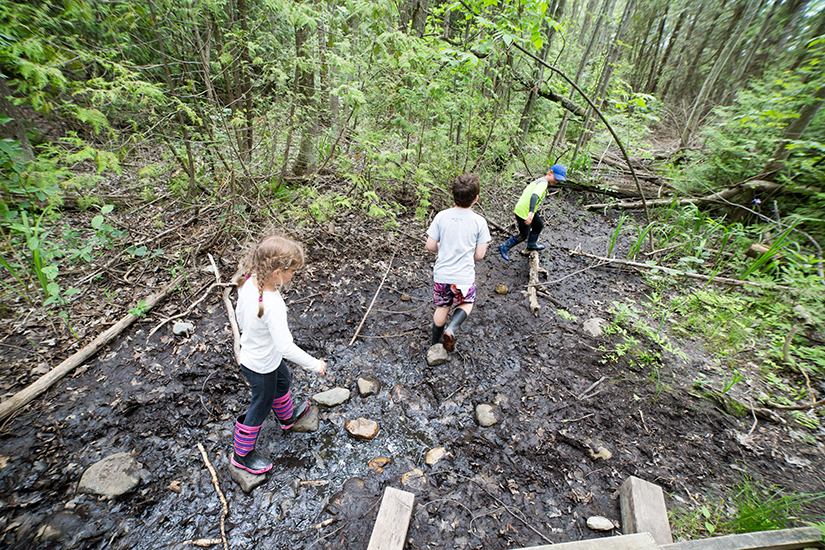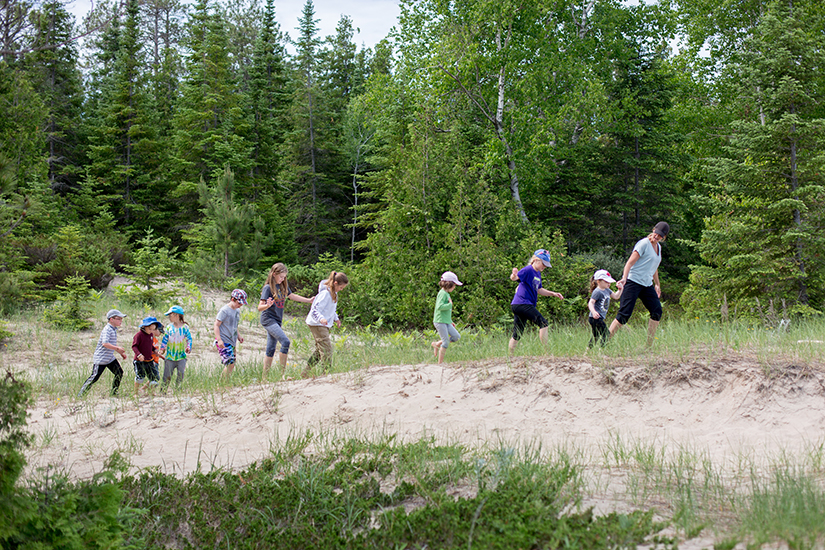When you think back to your childhood, what are some of your best memories?
Likely a lot of them involved playing and exploring in the outdoors.
Unfortunately, many children today don’t get this opportunity. Kids are often kept indoors by electronics and other distractions. They miss out on the developmental benefits of outdoor play.
This is where forest school comes in. Forest school combines nature with education for the ultimate outdoor learning experience.
Since September 2017, MacGregor Point Provincial Park has hosted Saugeen Shores Forest School, the first forest school in an Ontario provincial park.
What is forest school?

Saugeen Shores Forest School offers fully outdoor, play-based, and child-centred programs at MacGregor Point. The program runs two days a week and is open to children 18 months to 12 years.
This type of education focuses less on academic facts, instead giving kids the opportunity to play freely in nature.
Children spend most or all of their day outside learning about their natural environment, regardless of the weather.

Certified teachers (one for every six students) share an enthusiasm for nature and partner in the child’s learning process.
How does it work?
The base camp for the school is located at the day-use area at MacGregor Point.
The school uses a large renovated trailer as the indoor school space. The trailer is accessible for the entire year, however is only necessary during the winter months for children to warm up, change clothing, and eat their snacks and lunches.
Children will also head indoors in the case of thunder, lightning, extreme heat, or extreme cold.
Otherwise, the children spend their days doing hands-on outdoor lessons.
What do they learn?

Play is an important part of the Saugeen Shores Forest School.
Children love to play, and play often mirrors what is important in their lives. Children play for different reasons, whether it is to explore new things, practice skills, build relationships, or take physical and emotional risks. Important lessons can be learned from all of these.
Students need the exposure to risk that is available in the outdoors. The experience and management of risk is a fundamental part of forest school. Children learn about risk and rewards, as well as how to take responsibility for themselves and their actions.

Sometimes children work independently, finding a quiet space with themselves, their creations, and their thoughts. Other times, children work collaboratively to create something, problem solve, or tell stories.
Though forest school is play-based, children are continuously exposed to traditional disciplines like science, math, physical education, literacy, social sciences, and art.
Using the space at MacGregor Point

MacGregor Point offers everything a forest school needs.
The park offers a complex ecosystem of swamps, marshes, ponds, fens, and bogs, which bring a world of wonder to young minds. The fauna that thrive in the park will delight all ages.
In the warmer seasons, our students enjoy a range of activities in the park. Once the cold hits, snowshoeing, cross-country skiing, skating and birding are some of our favourite winter activities.

The woodland areas are used for lessons, exploration, and navigation. Students are taught to “leave no trace” as they explore the wild.
Using a forested area allows for games, nature lessons, temporary shelter construction, wood carving, knot tying, and learning to use tools. The school uses a fire circle to learn about fire building and outdoor cooking.
Benefits of forest school

This type of education may sound like all fun, but the benefits are plentiful.
At forest school, children will develop a lifelong relationship with the natural environment. Being outdoors awakens their senses, fosters curiosity, engages emotions, and makes them care about our environment and history.
The school promotes social inclusion and positive social interactions. Each student is taught confidence, creativity, communication, and resiliency. Students also learn how to work positively with others.

By its nature, forest school is also very physically active. Outdoor play improves motor skills such as agility, balance, and coordination. It reduces illness rates, heightens the overall use of senses, and reduces childhood obesity.
There are emotional benefits to forest school too. The program has been shown to reduce childhood anxiety and depression. Symptoms of ADD and ADHD are reduced or eliminated altogether. Time is spent fostering critical thinking and problem solving skills.
Lastly, it provides children the opportunity to develop independence, autonomy, and personal power.
All of these skills pave the way for academic learning and help the students become successful later in life.

Time in nature is good for you, plain and simple. To learn more about the benefits of time spent outdoors visit our Healthy Parks Healthy People page.
